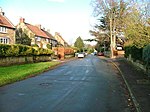Knayton with Brawith

Knayton with Brawith is a civil parish in the Hambleton district of North Yorkshire, England. The parish includes the village of Knayton and the hamlet of Brawith. Knayton with Brawith can be accessed from the A19. Within the village of Knayton, there are no shops. It is 4 miles north of Thirsk and Brawith Hall is approximately a mile away from Knayton. The local primary school is Knayton Church of England Primary school, which provides education for 148 children between the ages of 4 and 11 years old. The village has a village hall that is situated on the green. The hall sits 100 people and has kitchen and accessibility facilities. In the 1870s John Marius Wilson, described Knayton with Brawith as: "A township and a sub-district, in Thirsk district, N. R. Yorkshire. The township lies 4 miles NNE of Thirsk"
Excerpt from the Wikipedia article Knayton with Brawith (License: CC BY-SA 3.0, Authors, Images).Knayton with Brawith
Geographical coordinates (GPS) Address Nearby Places Show on map
Geographical coordinates (GPS)
| Latitude | Longitude |
|---|---|
| N 54.28565 ° | E -1.3372 ° |
Address
YO7 4AY , Knayton with Brawith
England, United Kingdom
Open on Google Maps










